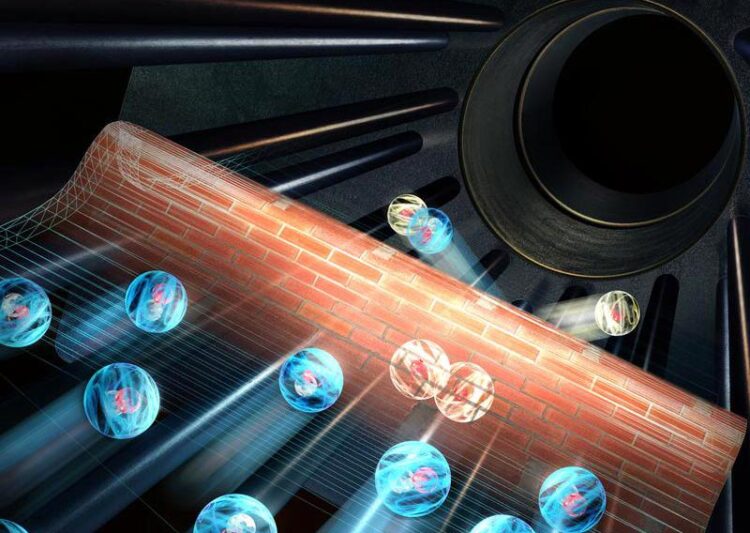Quantum Chemistry: Molecules caught tunneling

Quantum mechanics allows particles due to their quantum mechanical wave properties to break through the energetic barrier (wall) and a reaction occurs.
Credit: Harald Ritsch / Universität Innsbruck
Quantum effects can play an important role in chemical reactions. Physicists led by Roland Wester of the University of Innsbruck, Austria, have now for the first time observed a quantum mechanical tunneling reaction in experiments. The observation can also be described exactly in theory.
With the study published in Nature, the scientists provide an important reference for this fundamental effect in chemistry. It is the slowest reaction with charged particles ever observed.
Tunneling reactions in chemistry are very difficult to predict. The quantum mechanically exact description of chemical reactions with more than three particles is difficult, with more than four particles it is almost impossible. Theorists simulate these reactions with classical physics and must neglect quantum effects. But where is the limit of this classical description of chemical reactions, which can only provide approximations?
Roland Wester from the Department of Ion Physics and Applied Physics at the University of Innsbruck has long wanted to explore this frontier. “It requires an experiment that allows very precise measurements and can still be described quantum-mechanically,” says the experimental physicist. “The idea came to me 15 years ago in a conversation with a colleague at a conference in the U.S.,” Wester recalls. He wanted to trace the quantum mechanical tunnel effect in a very simple reaction.
Since the tunnel effect makes the reaction very unlikely and thus slow, its experimental observation was extraordinarily difficult. After several attempts, however, Wester’s team has now succeeded in doing just that for the first time, as they report in the current issue of the journal Nature.
Breakthrough after 15 years of research
Roland Wester’s team chose hydrogen – the simplest element in the universe – for their experiment. They introduced deuterium – a hydrogen isotope – into an ion trap, cooled it down and then filled the trap with hydrogen gas. Because of the very low temperatures, the negatively charged deuterium ions lack the energy to react with hydrogen molecules in the conventional way. In very rare cases, however, a reaction does occur when the two collide.
This is caused by the tunnel effect: “Quantum mechanics allows particles to break through the energetic barrier due to their quantum mechanical wave properties, and a reaction occurs,” explains the first author of the study, Robert Wild. “In our experiment, we give possible reactions in the trap about 15 minutes and then determine the amount of hydrogen ions formed. From their number, we can deduce how often a reaction has occurred.”
In 2018, theoretical physicists had calculated that in this system quantum tunneling occurs in only one in every hundred billion collisions. This corresponds very closely with the results now measured in Innsbruck and, after 15 years of research, for the first time confirms a precise theoretical model for the tunneling effect in a chemical reaction.
Foundation for a better understanding
There are other chemical reactions that might exploit the tunnel effect. For the first time, a measurement is now available that is also well understood in scientific theory. Based on this, research can develop simpler theoretical models for chemical reactions and test them on the reaction that has now been successfully demonstrated.
The tunnel effect is used, for example, in the scanning tunneling microscope and in flash memories. The tunnel effect is also used to explain the alpha decay of atomic nuclei. By including the tunnel effect, some astrochemical syntheses of molecules in interstellar dark clouds can also be explained. The experiment of Wester’s team thus lays the foundation for a better understanding of many chemical reactions.
The research was financially supported by the Austrian Science Fund FWF and the European Union, among others.
Wissenschaftliche Ansprechpartner:
Roland Wester
Department of Ion Physics and Applied Physics
University of Innsbruck
p +43 512 507-52620
e roland.wester@uibk.ac.at
w https://www.uibk.ac.at/ionen-angewandte-physik
Originalpublikation:
Tunneling measured in a very slow ion-molecule reaction. Robert Wild, Markus Nötzold, Malcolm Simpson, Thuy Dung Tran, and Roland Wester. Nature 2023 DOI: 10.1038/s41586-023-05727-z https://www.nature.com/articles/s41586-023-05727-z
Media Contact
All latest news from the category: Physics and Astronomy
This area deals with the fundamental laws and building blocks of nature and how they interact, the properties and the behavior of matter, and research into space and time and their structures.
innovations-report provides in-depth reports and articles on subjects such as astrophysics, laser technologies, nuclear, quantum, particle and solid-state physics, nanotechnologies, planetary research and findings (Mars, Venus) and developments related to the Hubble Telescope.
Newest articles

Innovative 3D printed scaffolds offer new hope for bone healing
Researchers at the Institute for Bioengineering of Catalonia have developed novel 3D printed PLA-CaP scaffolds that promote blood vessel formation, ensuring better healing and regeneration of bone tissue. Bone is…

The surprising role of gut infection in Alzheimer’s disease
ASU- and Banner Alzheimer’s Institute-led study implicates link between a common virus and the disease, which travels from the gut to the brain and may be a target for antiviral…

Molecular gardening: New enzymes discovered for protein modification pruning
How deubiquitinases USP53 and USP54 cleave long polyubiquitin chains and how the former is linked to liver disease in children. Deubiquitinases (DUBs) are enzymes used by cells to trim protein…


